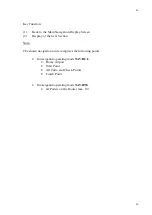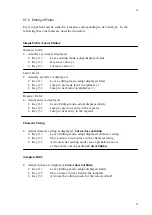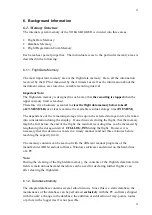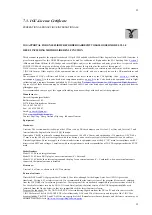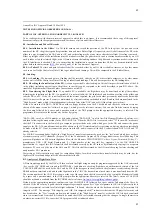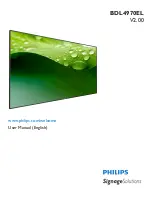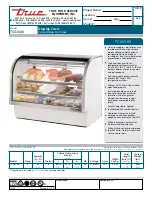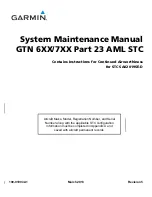
40
40
CONDITIONS OF APPROVAL
1. Permitted Connections to the Main (FR) Module.
The external connector for battery power and I/O signals consists of a circular metal 5-pin Binder-type female connector with a
screw-in attachment, fitted to the end of the case, and, for the models VL1.0E and 1.0C, an external antenna plug. A "Y" shaped
external cable connects the 5-pin plug to a 12 volt source and also to a 9-pin female RS232 socket for connecting to the COM
port of a PC. The external connector on the FR may also be used for transmitting NMEA-format data from the FR to other glider
instruments.
2. Security of the Equipment.
GFAC is presently satisfied with the physical and electronic security of this equipment. See
para 4
on security seals.
2.1. Installation in a glider:
The FR may be fitted anywhere in the glider, subject to paras 2.2 and 3.2. If the GPS
antenna is accessible to the crew in flight, no attempt must be made to inject data; any abuse of this may lead to a future
requirement to place the antenna out of reach of the flight crew.
2.2. Motor gliders.
When the Garrecht ENL system is fitted (Version VL1.1), a microphone and frequency filter and
weighting system automatically produces an ENL (Engine Noise Level) value with each fix up to a maximum ENL value
of 999. The system is designed to emphasise engine noise but at the same time produce positive but low ENL values in
normal gliding flight. The FR should be positioned in the glider so that it can receive a good amount of engine and/or
propellor noise when power is being generated. GFAC has tested the FR in motor gliders with two-stroke and 4-stroke
engines, but not with Wankel or electric power sources. For details see
para B.4
.
2.3. Sealing of data ports and plugs:
no present requirement, but no attempt must be made to pass unauthorised data
into the FR.
2.4. Data Transfer from the FR to a PC.
The DATA-GCS.EXE file menu provides two modes of transfer, a "Test"
mode and a "High Security" mode. Only the High Security mode provides the electronic security signature which is
required for validation of FAI/IGC record and badge flights. Data transferred by the "Test" mode will not be accepted for
such flights, and it will not pass the VALI check (
para 5
), although competition organisers may allow it for competition
flights where rapid data transfer rather than security is a priority in well-supervised centralised competitions.
3. Check of Installation in the Glider.
There must be incontrovertible evidence that the FR was correctly installed in the glider for the flight concerned. This can be
achieved either by observation at takeoff or landing or by sealing the FR to the glider at any time or date before takeoff and
checking the seal after landing.
3.1. Observation of Installation before Takeoff or at Landing.
For observation, either a preflight check of the
installation must be made and the glider must be under continuous observation by an OO until it takes off on the claimed
flight, or an OO must witness the landing and have the glider under continuous observation until the FR installation is
checked. This is to ensure that the installation is in accordance with the rules, and that another FR has not been
substituted before the data is transferred to a PC after flight.
3.2. Sealing to the Glider.
If para 3.1 cannot be met, the FR must be sealed to the glider by an OO at any time or
date before flight so that it cannot be removed without breaking the seal. The sealing method must be acceptable to the
NAC and IGC. Paper seals must be marked in a manner such that there is incontrovertible proof after the flight that
seals have not been tampered with, such as by marking with the glider registration, the date, time and OO's name and
signature. The use of adhesive plastic tape is not satisfactory for IGC-approved sealing because it can be peeled off and
re-fitted. Gummed paper tape is recommended, as used for sealing drum-type barographs. The OO must seal the FR unit
to glider parts which are part of the minimum standard for flight. It is accepted that such parts can be removed for
purposes such as servicing; such parts include the canopy frame, instrument panel, and centre-section bulkhead fittings.
If the FR is sealed to such removable part, if such a part is transferred between gliders, any FR seal for the previous
glider must be removed.
4. Security Seals, Physical and Electronic.
A silver-coloured tamper-evident seal with the European "CE Mark" and the manufacturer’s name, is fitted over one of the case
securing screws. In addition, an internal electronic security mechanism is included and the electronic security check will no longer
produce a valid IGC file if the case has been opened. On switching on, after the LCD screen shows the unit serial number, it should
then show "Security Seal OK" for a short time. If the FR is found to be unsealed either physically or electronically, it must be
returned to the manufacturer or his appointed agent for investigation and resealing, with a statement of how the unit became
unsealed. Whenever any unit is resealed, the manufacturer or agent must carry out positive checks on the internal programmes
and wiring, and ensure that they work normally. If any evidence is found of tampering or unauthorised modification, a report must
be made by the manufacturer or agent to the Chairman of GFAC and to the NAC of the owner; the IGC approval of that
individual unit will be withdrawn until the unit is re-set and certified to be to the IGC-approved standard.
5. Analysis of Flight Data
may be through any analysis programme which is approved by the relevant NAC. For a list of those which use the *.IGC file
format, see the IGC GNSS web site under SOFTWARE). The NAC must check that the *.IGC file is valid and unaltered, by the use

